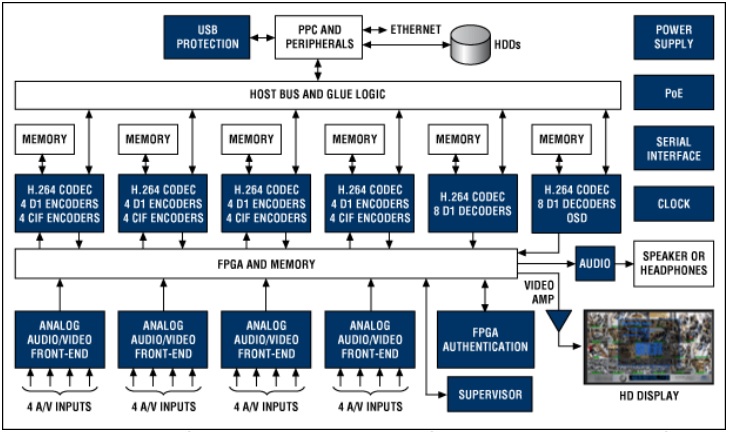Abstract of DVR
This application note introduces the types of compression security and surveillance-video technologies used today and the inherent strengths of some video-compression standards. The discussion covers the basic concept of how DVR digital recorders utilize legacy CCTV and IP camera inputs―they utilize the H.264 video compression standard to compress signals, allowing increased storage of data and higher-quality transmission over networks, even those with lower bit rates.
Overview of DVR
Analog CCTV security systems are moving to digital technology, and video recording is leading this transition. The analog VCR has been replaced by digital video recorders (DVRs) in security systems that require video monitoring and recording. DVRs now offer overwhelming advantages over analog VCRs in security applications. Video footage can be digitally recorded, processed, and streamed over digital networks at virtually any level of image quality, including high definition (HD). Users now make use of digital-only technologies such as real-time analytics, scene search, motion- and activity-detection alarms, and remote access over IP networks.
The cost of storage capacity on physical media such as hard disk drives (HDDs), digital versatile discs (DVDs), or network-attached storage (NAS) is a small fraction of analog tape-based recording cost. The use of digital video recording and archiving also offers permanent storage of video footage with no loss of image quality over time. All of these factors have driven the security industry toward adopting DVR as the standard for video recording.
DVR Types
The security market has evolved into multiple segments for DVR systems. Embedded, hybrid, and PCbased DVRs all require the essential elements of video and audio capture: analog-to-digital conversion, compression, playback, and network streaming. The embedded DVR is a stand-alone piece of equipment that accepts analog CCTV camera inputs for compression and storage on a local HDD. Hybrid DVRs accept analog CCTV and IP camera inputs as video sources. PC-based DVRs are integrated into surveillance stations with hardware compression add-in cards or software compression running on the PC.
The distinguishing features among different models are the number of video input channels; compression standards supported; video quality of the record, stream, and display modes; storage capacity; and how many functions the system can perform simultaneously.
Functional block diagram of a security DVR system.
Video-Compression Technologies
H.264 is the new industry standard for video compression in security DVRs. Prior generations used MPEG-4 and even MJPEG for video recording. H.264 has the advantage of offering the highest compression ratio, while maintaining excellent video quality for security applications. H.264’s higher compression ratio (up to two times better than prior generation technology) effectively increases storage capacity by 100%, producing smaller file sizes and, therefore, longer recording time on a fixed-capacity storage device. In addition, the use of H.264 allows high-quality images to be transmitted over networks at very low bit rates.
Security systems that involve multiple cameras can quickly exceed the available network bandwidth without efficient compression. DVR system designs without H.264 often rely on reduced-framerate or lower resolution recording techniques that degrade picture quality in order to increase recording time and reduce video bit rates. Older codec formats (MPEG-4 and MJPEG) are often still required for legacy support, but the industry’s trend to adopt H.264 as the primary codec in DVR is well under way. Maxim’s family of H.264 processors supports MJPEG recording and playback for backward compatibility with priorgeneration equipment.
DVR System Requirements
Security video applications are moving to higher recording and display resolutions. CIF resolution recording (NTSC 360 x 240) was used extensively in early generation DVRs to produce digital video quality comparable to the analog VCR it replaced. Low-resolution CIF was also well suited to firstgeneration codec technology (MJPEG/MPEG-4) that cannot produce acceptable compression ratios at higher resolutions.
The market requirement today and moving forward is standard-definition (D1 NTSC 720 x 480) or “DVD-quality” video recording. Standard definition (SD) represents a fourfold performance increase in system processing power per channel as compared to CIF. State-of-the-art H.264 codec technology is used at D1 resolution and above to ensure efficient compression ratios.
Maxim’s family of H.264 processors allows programmable video resolutions for recording at any level of quality required.
Another trend in security and surveillance video is the requirement for full-frame-rate video recording and storage. Full frame rate for an analog CCTV camera is 30 frames per second (fps) in NTSC and 25fps in PAL. Real-time video recording represents a twofold to fourfold increase in processing power required per channel versus DVR designs that record at reduced frame rates such as 7.5fps (25% in NTSC) or 15fps (50% in NTSC). A powerful, scalable system architecture is required to meet the processing requirements of new DVR designs.
Many video security systems today are hybrid designs of analog CCTV equipment and digital network technologies that have built up over time. Preexisting digital equipment based on older codec technologies (MJPEG/MPEG-4) creates the need for transcoding between formats in new equipment. For example, the video from an existing IP camera with MJPEG compression must be re-encoded to H.264 in the DVR for efficient storage and network bandwidth usage. DVR designs today must accommodate multiformat digital video input (MJPEG/MPEG-4/H.264) to preserve investments made in earlier generation equipment. Maxim’s family of H.264 processors supports video decoding in MJPEG and MPEG2, prior to re encoding to H.264, for recording and streaming.
: www.maximintegrated.com/DVR.


